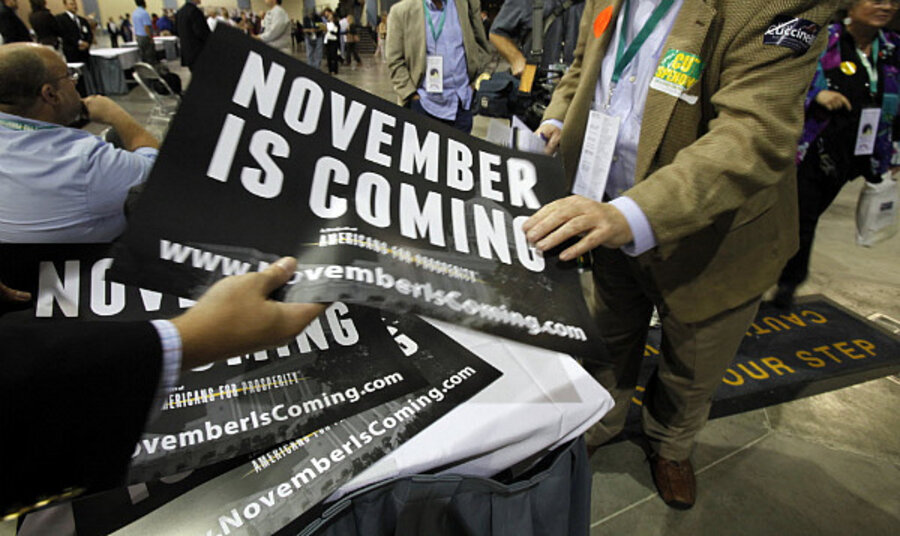Tea party convergence: Big boost for Republicans in Election 2010
Loading...
It’s still three weeks and a couple days before the midterm election. But the likelihood of a Republican takeover in Congress just keeps growing, powered by a major boost from the tea party movement – a political phenomenon that has evolved from a scattered and sometimes flaky insurgency into a sophisticated, organized effort.
In his latest estimate, polling expert Nate Silver of the FiveThirtyEight blog says Republicans have a 72 percent chance of taking over the House, up from 67 percent last week. Also, he writes in his latest New York Times column, the GOP has “nearly even odds of a achieving a net gain of 50 seats” – 11 more than it needs to become the majority party in the House.
No doubt that’s thanks in large measure to the higher level of preelection energy among tea-fueled Republicans.
The latest survey conducted jointly by the Washington Post, the Henry J. Kaiser Family Foundation, and Harvard University shows why.
“On every measure, strong supporters of the tea party movement stand above the rest of the field,” writes Dan Balz in the Post.
“For starters, take the question of whether people are very interested in these elections,” Balz writes. “Forty-three percent of Democrats said they are. Among Republicans, 57 percent said they're very interested. Among tea party supporters the figure was 74 percent, and among the strongest tea party supporters it was 83 percent.”
Tea partyers want a GOP Congress
While the Republican Party has had its run-ins with tea partyers – most notably in GOP primaries where establishment candidates got whacked – the Washington Post-Kaiser-Harvard poll shows a large majority of tea party supporters favoring a GOP takeover of Congress.
Meanwhile, what probably should have been called the “tea parties” – over the past year there have been many disparate and sometimes contending groups – are becoming more organized and unified as the election approaches.
In Virginia, for example, groups from around the state have formed a federation called “Virginia Tea Party Patriots.” The group just held a two-day convention in Richmond.
Similar coordinating efforts are underway in Michigan, Pennsylvania, Indiana, Virginia, Texas, and Ohio, reports the Wall Street Journal. And for now, at least, tea party groups are lining up behind Republican candidates for the most part – which Democrats warn is a scary development.
Wary alliance
But a tea party tag can be tricky.
Of those surveyed by CBS News last week, the split between those with a favorable/unfavorable view of the tea party movement is virtually even – 22-21 percent with 56 percent undecided. But of those registered voters who have formed an opinion of the movement, 29 percent say they’re less likely to vote for a candidate with tea party connections compared to 16 percent who are more likely to vote for such a candidate.
Those are abstract questions, however, lacking a specific candidate’s face or record, which can make a big difference.
Take the two most interesting (and controversial) tea party-backed Republican candidates for the US Senate: Sharron Angle in Nevada and Christine O’Donnell in Delaware.
A University of Delaware poll has O’Donnell lagging behind Democrat Chris Coons by 19 percentage points (24 percent when “leaners” are added in). But in Nevada, Angle has a slight edge over incumbent Senate majority leader Harry Reid, according to several polls.
In Pennsylvania (where President Obama is campaigning Sunday), Republican Pat Toomey is leading Democrat Joe Sestak by nine points in the latest McClatchy-Marist survey. As Benjamin Sarlin points out in the Daily Beast, Toomey “was the Tea Party candidate before the Tea Party even existed.”
A problem with peripheral issues
But for Republicans to prevail, they need to avoid being distracted by peripheral issues, warns Grover Norquist, president of Americans for Tax Reform and an influential voice in conservative politics.
“The party and its energized Tea Party activists have a habit of becoming distracted by ‘shiny’ things – issues that captivate radio talk show hosts but fail to move voters,” Norquist wrote recently in the Financial Times. “Arizona’s restrictive immigration law and the proposed mosque in lower Manhattan are obvious examples. Speculating on the precise location where Mr. Obama was born is another. Some social conservatives are trying to push to the fore the issue of gay marriage or gays in the military, and that too is a distraction.”
“If Republicans stay focused on [government] spending they will triumph,” Norquist predicts. “But the Democrats know that, and will throw a shower of bling into the air hoping to distract both voters and their challengers. To win, these diversions must be ignored.”





